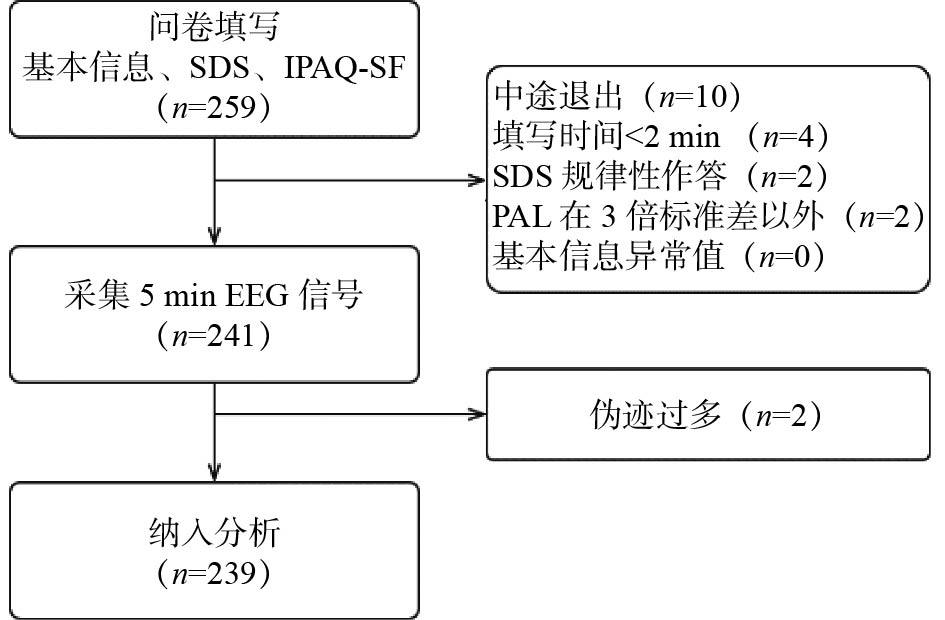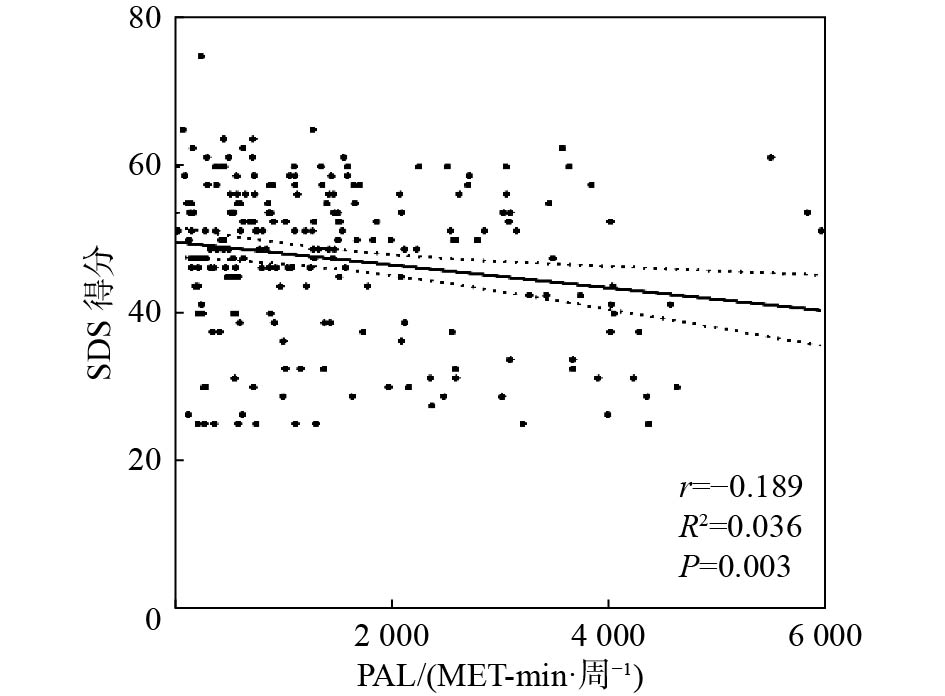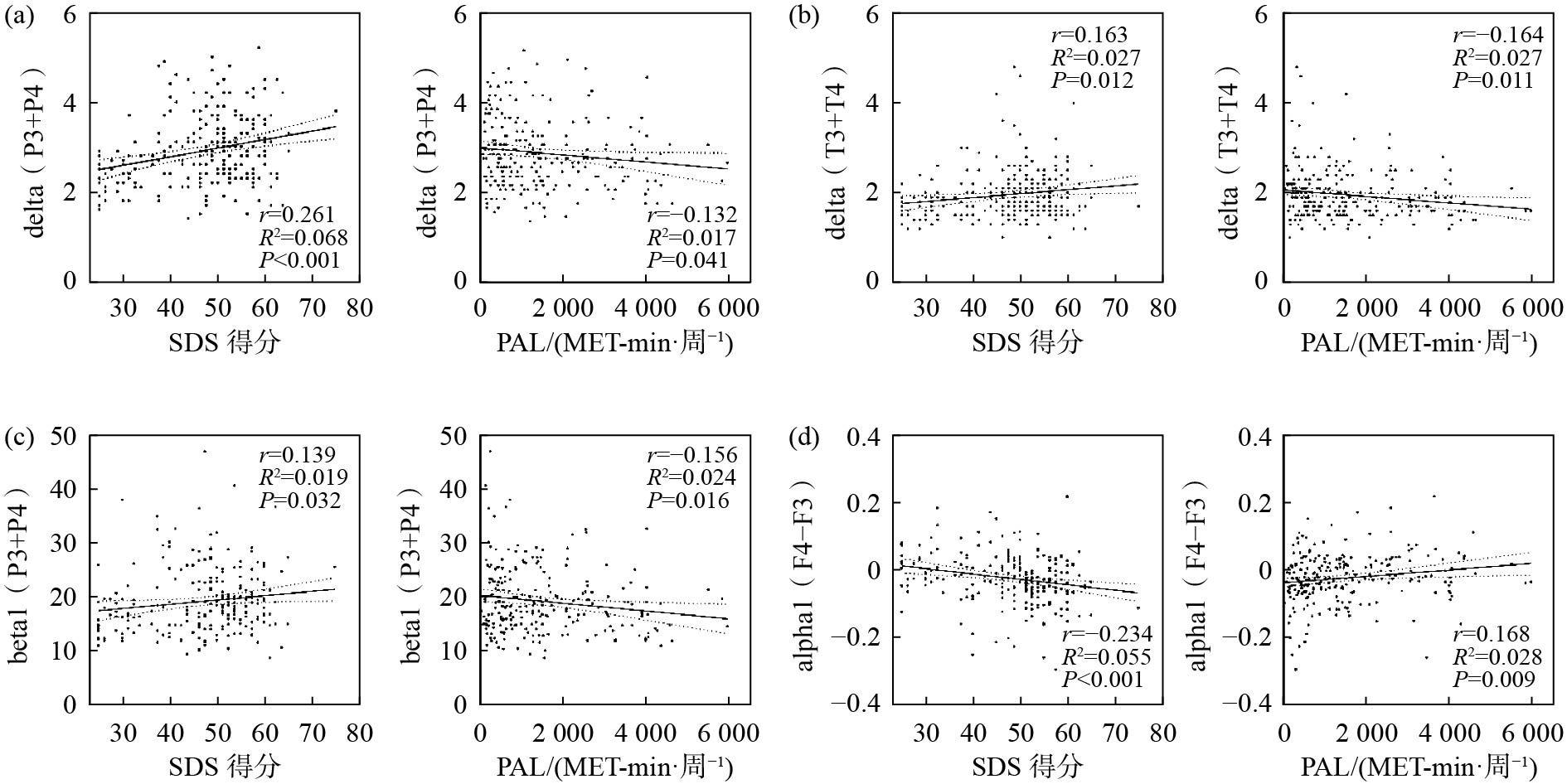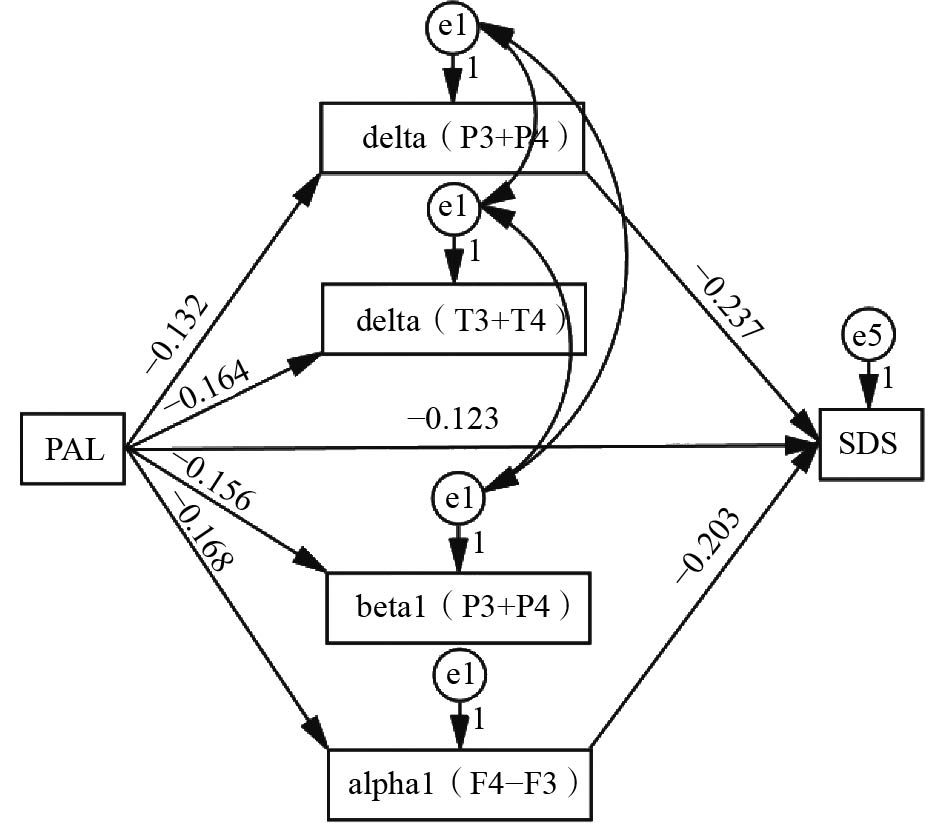Relationship Between Physical Activity Level and Depressive Symptoms in College Students: A Pathway Analysis Based on EEG
-
摘要:目的
基于静息脑电(EEG)分析大学生身体活动水平与抑郁症状的关系,探寻身体活动对抑郁症状的潜在作用路径。
方法随机招募239名大学生填写《抑郁自评量表》《国际身体活动问卷短卷》,采集5 min EEG信号。
结果大学生身体活动水平为1109(509,2232) MET-min/周,抑郁评分为47.401±10.562,二者显著负相关(r=−0.189,P=0.003);中央区、顶区delta功率值,眶额、前额theta功率值与前额alpha1右侧化对抑郁评分具有19.89%的解释力( R2=0.199,P<0.001);顶区、颞区delta功率值,顶区beta1功率值和前额alpha1右侧化与身体活动水平及抑郁评分均显著相关(P<0.05),且相关方向相反;身体活动水平对抑郁评分具有65.37%的直接效应(B=−0.123,95% CI: −0.260~0.016),顶区delta功率值介导16.56%的中介效应(B=−0.031,95% CI: −0.073~−0.005),前额alpha1右侧化介导18.07%的中介效应(B=−0.034,95% CI: −0.072~−0.010)。
结论识别抑郁倾向大学生需重点关注中央区、顶区delta功率值的上升和额区theta功率值、前额alpha1右侧化的下降,这可能与其睡眠节律紊乱、情绪调节能力不足及压力感知过大有关;随着身体活动水平增加,其抑郁评分呈下降趋势,顶区delta功率值下降和前额alpha1右侧化上升可能是体育锻炼改善抑郁症状的作用路径,与体育锻炼改善睡眠节律、增强情绪调节能力有关。
Abstract:ObjectiveTo analyze the relationship between physical activity level, resting electroencephalography (EEG) and depressive symptoms in college students, and to explore the potential roles of physical activity (PA) on depressive symptoms.
Methods239 college students were randomly recruited to fill in the Self-rating Depression Scale (SDS) and the International Physical Activity Questionnaire-Short Form (IPAQ-SF). EEG signals were collected for 5 minutes.
ResultsPA level of college students was 1109 (509, 2232) MET-min/week, and the depression score was 47.401±10.562. There was a significant negative correlation between the PA and SDS score (r=−0.189, P=0.003). The delta power value of central region and parietal region, theta power value of orbitofrontal and frontal region and right-sided alpha1 of forehead had 19.89% explanation for SDS score (R2=0.199, P<0.001). The delta power value of parietal region and temporal region, beta1 power value of parietal region and right-sided alpha1 of forehead were significantly correlated with PA and SDS score (P<0.05), and the correlation direction was opposite. The direct effect of PA on SDS score was 65.37% (B=−0.123, 95% CI: − 0.260-0.016), the delta power value of the top region mediated 16.56% of the mediation effect (B=−0.031, 95% CI: −0.073-−0.005), and right-sided alpha1 in the forehead mediated 18.07% of the mediating effect (B=−0.034, 95% CI: −0.072-−0.010).
ConclusionTo identify the depressive tendency of college students, more attention should be paid to the increase of delta power in central region and parietal region and the decrease of theta power in frontal region and right-sided alpha1 in frontal region, which may be related to sleep rhythm disorder, insufficient emotion regulation ability and excessive stress perception. The decreased delta power value of the parietal region and the increased right-sided degree of frontal alpha1 may be the action path of physical exercise to improve depressive symptoms. It may be related to physical exercise’s improving sleep rhythm and enhancing emotional regulation ability.
-
Keywords:
- college student /
- physical activity level /
- EEG /
- depressive symptom /
- mediation model
-
近年来,反事实思维作为一种常见的心理现象广泛存在于各个领域。在体育领域,反事实思维对运动员面部表情和情绪有着重要影响。研究者发现,铜牌得主在赛后似乎比银牌得主更快乐,并表现出更多的“杜氏”微笑。对于这一现象存在两种突出的解释:①银牌得主倾向于与金牌得主进行向上比较,认为自己几乎可以获得金牌;铜牌得主倾向于与非奖牌得主进行向下比较,认为自己至少获得了奖牌。②银牌得主之前对表现的期望高于铜牌得主。银牌得主与铜牌得主究竟谁更快乐?研究者基于反事实思维视角给出了解释。美国明尼苏达大学的William M. Hedgcock和爱荷华大学的Andrea W. Luangrath等学者在2020年收集了2000—2016年奥运会中来自142个体育项目的4 133名运动员的照片,通过面部表情自动编码软件(基于面部行为编码系统,FACS)对奖牌得主的照片进行编码和分析,并使用“广义线性混合模型”和重复测量设计验证了相关预测。结果表明:银牌得主在赛后会使用向上的反事实思维,表现出不快乐;铜牌得主会形成向下的反事实思维,表现出更多微笑;运动员的面部表情不仅与其绝对表现有关,还与之前的表现期望有关。
该研究创新性地从反事实思维视角揭示了运动表现对面部表情的影响,为我国运动员赛前和赛后的情绪调整提供了重要启示:对于可能获得银牌的运动员,赛前引导其不要作出较高表现水平的预期,赛后引导其形成向下的反事实思维(例如,至少我比第3名做得好);对于可能获得铜牌的运动员,赛前引导其作出高表现水平的预期(例如,我可以做得更好),激发其动力,赛后引导其与未获得奖牌者进行向下比较。后续研究可以结合情绪归因理论,测量奥运奖牌得主常见的其他情绪以及整个赛后的情绪,并评估除面部表情以外的其他身体语言。根据研究现状,建议未来可测量反事实思维的结构,结合认知神经科学工具和技术(ERP、EEG、fNIRS等)研究反事实思维的脑机制,进一步探讨反事实思维对奥运奖牌得主情绪影响的神经机制,并进行跨文化和跨种族的比较,为此影响的普适性提供参考。
作者贡献声明:王芃:提出论文主题,统计处理数据,撰写论文;作者贡献声明:王靖、赵津磊:修改论文;作者贡献声明:王相、辛鑫、裘莎丽、臧育恒:参与测试,核实数据;作者贡献声明:王兴:梳理论文思路,指导修改论文。 -
表 1 不同抑郁症状大学生的人口统计学变量差异
Table 1 Differences in demographic variables of college students with different depressive symptoms
变量 整体(n=239) 抑郁(n=92) 正常(n=147) 差异性检验 PAL/(MET-min·周-1) 1109(509,2232) 1103.5(546.5,1692.5) 1161(465,2480) Z=−0.677,P=0.499 年龄/岁 20.226±1.698 20.109±1.800 20.299±1.632 t=−0.844,P=0.399 BMI/(kg·m-2) 22.032±3.443 22.560±3.954 21.702±3.048 t=1.885,P=0.078 独生子女(是/%) 48.12 47.83 48.30 χ2=0.005,P=0.943 户籍地(城镇/%) 50.63 53.26 48.98 χ2=0.415,P=0.519 吸烟习惯(有/%) 5.44 6.52 4.76 χ2=0.341,P=0.559 饮酒习惯(有/%) 8.37 11.96 6.12 χ2=2.512,P=0.113 表 2 各脑区各频段EEG指标与SDS得分的相关系数
Table 2 Correlation coefficient between SDS score and EEG indexin in different brain regions
脑区指标 delta theta alpha1 alpha2 beta1 beta2 功率值 FP1+FP2 0.010 −0.033 0.057 0.076 −0.004 −0.043 F3+F4 −0.074 −0.124 −0.068 −0.056 −0.051 −0.075 F7+F8 0.113 0.048 0.010 0.050 −0.075 −0.119 C3+C4 0.221** 0.136* 0.114 0.123 0.093 −0.019 P3+P4 0.261*** 0.176** 0.204* 0.194** 0.139* 0.065 O1+O2 0.213** 0.167* 0.144* 0.164* 0.119 −0.004 T3+T4 0.163* 0.102 0.088 0.095 0.070 −0.028 T5+T6 0.239*** 0.178** 0.153* 0.168** 0.115 0.050 偏侧化 FP2−FP1 −0.082 −0.110 −0.109 −0.137* −0.123 0.084 F4−F3 −0.190** −0.175** −0.234*** −0.213** −0.142* 0.079 F8−F7 0.123 0.101 0.003 −0.074 −0.006 0.018 C4−C3 −0.148* −0.119 −0.141* −0.157* −0.076 0.032 P4−P3 −0.108 −0.106 −0.091 −0.106 −0.059 −0.008 O2−O1 −0.027 −0.054 −0.002 0.016 0.070 0.062 T4−T3 −0.114 −0.117 −0.062 −0.079 −0.042 0.006 T6−T5 −0.074 −0.070 −0.085 −0.106 −0.067 −0.022 注:*、**、***分别表示P<0.05、P<0.01、P<0.001。 表 3 EEG指标对SDS得分的多元线性逐步回归分析结果
Table 3 Results of multiple linear stepwise regression analysis of EEG indicators on SDS scores
自变量 B 95% CI Beta 系数显著性检验 SE 共线性诊断 t P 容差 VIF delta(C3+C4) 4.710 [1.248,8.173] 0.272 2.680 0.008** 1.757 0.335 2.987 delta(P3+P4) 3.456 [1.017,5.896] 0.253 2.792 0.006** 1.238 0.417 2.399 theta(FP1+FP2) −0.445 [−0.804,−0.087] −0.211 −2.449 0.015* 0.182 0.463 2.161 theta(F3+F4) −0.368 [−0.646,−0.090] −0.214 −2.611 0.010* 0.141 0.511 1.958 alpha1(F4−F3) −24.459 [−41.798,−7.120] −0.169 −2.779 0.006** 8.801 0.927 1.078 模型摘要 F=11.602***,R2=0.199,R=0.446,ΔR2=0.182 注:*、**、***分别表示P<0.05、P<0.01、P<0.001;B表示非标准化系数,Beta表示标准化系数。 表 4 大学生身体活动水平与EEG特异性指标的相关关系
Table 4 Correlation between physical activity level and EEG specific indicators of college students
频段 功率值指标 相关系数 偏侧化指标 相关系数 delta delta(C3+C4) −0.119 delta(F4−F3) 0.116 delta(P3+P4) −0.132* delta(C4−C3) −0.005 delta(O1+O2) −0.070 delta(T3+T4) −0.164* delta(T5+T6) −0.049 theta theta(C3+C4) −0.104 theta(F4−F3) 0.114 theta(P3+P4) −0.108 theta(O1+O2) −0.078 theta(T5+T6) −0.053 alpha1 alpha1(P3+P4) −0.015 alpha1(F4−F3) 0.168** alpha1(O1+O2) 0.020 alpha1(C4−C3) 0.041 alpha1(T5+T6) 0.057 alpha2 alpha2(P3+P4) −0.063 alpha2(FP2−FP1) 0.085 alpha2(O1+O2) −0.063 alpha2(F4−F3) 0.102 alpha2(T5+T6) 0.008 alpha2(C4−C3) 0.045 beta1 beta1(P3+P4) −0.156* beta1(F4−F3) 0.074 注:*、**分别表示P<0.05、P<0.01。 表 5 中介效应Bootstrap检验结果
Table 5 Results of Bootstrap test of mediating effect
效应类型 B 95% CI P SE 效应占比/% 总效应 −0.189 [−0.330,−0.051] 0.010 0.070 100 直接效应 −0.123 [−0.260,0.016] 0.085 0.069 65.37 delta(P3+P4)
中介效应−0.031 [−0.073,−0.005] 0.021 0.017 16.56 alpha1(F4−F3)
中介效应−0.034 [−0.072,−0.010] 0.005 0.015 18.07 注:B表示路径系数。 -
[1] PARK L T,ZARATE C A Jr. Depression in the primary care setting[J]. New England Journal of Medicine,2019,380(6):559-568 doi: 10.1056/NEJMcp1712493
[2] 王蜜源,刘佳,吴鑫,等. 近十年中国大学生抑郁症患病率的Meta分析[J]. 海南医学院学报,2020,26(9):686-693,699 [3] 赵颖,王艳秋,王俊,等. 大学生自伤行为抑郁焦虑现况及相关性分析[J]. 中国学校卫生,2021,42(1):92-95 [4] 金岳龙,常微微,常鑫,等. 大学生新冠肺炎疫情在线学习期间心理健康及影响因素分析[J]. 中国学校卫生,2021,42(4):574-578 [5] 王冬翠,陈真诚,杨超,等. 抑郁相关脑电变化规律的研究进展[J]. 中国现代医学杂志,2014,24(9):46-51 doi: 10.3969/j.issn.1005-8982.2014.09.010 [6] 刘潇雅,刘爽,郭冬月,等. 抑郁症脑电特异性研究进展[J]. 中国生物医学工程学报,2020,39(3):351-361 doi: 10.3969/j.issn.0258-8021.2020.03.13 [7] DUNCAN W C Jr,SELTER J,BRUTSCHE N,et al. Baseline delta sleep ratio predicts acute ketamine mood response in major depressive disorder[J]. Journal of Affective Disorders,2013,145(1):115-119 doi: 10.1016/j.jad.2012.05.042
[8] CLARK D L,BROWN E C,RAMASUBBU R,et al. Intrinsic local beta oscillations in the subgenual cingulate relate to depressive symptoms in treatment-resistant depression[J]. Biological Psychiatry,2016,80(11):e93-e94 doi: 10.1016/j.biopsych.2016.02.032
[9] KNOTT V,MAHONEY C,KENNEDY S,et al. EEG power,frequency,asymmetry and coherence in male depression[J]. Psychiatry Research,2001,106(2):123-140 doi: 10.1016/S0925-4927(00)00080-9
[10] Fingelkurts A A. Altered structure of dynamic electroencephalogram oscillatory pattern in major depression[J]. Biological Psychiatry,2015,77(12):1050-1060 doi: 10.1016/j.biopsych.2014.12.011
[11] BACHMANN M,LASS J,SUHHOVA A,et al. Spectral asymmetry and Higuchi's fractal dimension measures of depression electroencephalogram[J]. Computational and Mathematical Methods in Medicine,2013,2013:251638
[12] HALLGREN M,STUBBS B,VANCAMPFORT D,et al. Treatment guidelines for depression:Greater emphasis on physical activity is needed[J]. European Psychiatry:The Journal of the Association of European Psychiatrists,2017,40:1-3 doi: 10.1016/j.eurpsy.2016.08.011
[13] 李婷婷,伍晓艳,陶舒曼,等. 大学生体力活动与身体健康及抑郁症状的关联[J]. 中国学校卫生,2020,41(6):867-870 [14] 李秋利,关尚一,张少生. 大学生体力活动、心肺耐力与抑郁风险关系的纵向研究[J]. 山东体育学院学报,2015,31(4):78-82 doi: 10.3969/j.issn.1006-2076.2015.04.015 [15] 陈敏,张晓波,罗玉珍,等. 运动锻炼改善抑郁症的神经生物学相关机制研究进展[J]. 中国体育科技,2021,57(4):89-97 [16] 夏杰,刘微娜,漆正堂,等. PGC-1α介导的“肌脑Crosstalk”与运动的抗抑郁机制:基于整合生物学的反思与展望[J]. 上海体育学院学报,2017,41(4):57-64 [17] MORAES H,DESLANDES A,SILVEIRA H,et al. The effect of acute effort on EEG in healthy young and elderly subjects[J]. European Journal of Applied Physiology,2011,111(1):67-75 doi: 10.1007/s00421-010-1627-z
[18] WOO M,KIM S,KIM J,et al. The influence of exercise intensity on frontal electroencephalographic asymmetry and self-reported affect[J]. Research Quarterly for Exercise and Sport,2010,81(3):349-359 doi: 10.1080/02701367.2010.10599683
[19] 郭郁. 三圆式站桩功“调心”效应缓解抑郁状态的生理及基因表达机制研究[D]. 北京: 北京中医药大学, 2019: 173-179 [20] LATTARI E,PORTUGAL E,MORAES H,et al. Acute effects of exercise on mood and EEG activity in healthy young subjects:A systematic review[J]. CNS & Neurological Disorders Drug Targets,2014,13(6):972-980
[21] GRAMKOW M H,HASSELBALCH S G,WALDEMAR G,et al. Resting state EEG in exercise intervention studies:A systematic review of effects and methods[J]. Frontiers in Human Neuroscience,2020,14:155 doi: 10.3389/fnhum.2020.00155
[22] 王征宇,迟玉芬. 抑郁自评量表(SDS)[J]. 上海精神医学,1984(2):71-72 [23] 屈宁宁,李可基. 国际体力活动问卷中文版的信度和效度研究[J]. 中华流行病学杂志,2004,25(3):265-268 doi: 10.3760/j.issn:0254-6450.2004.03.021 [24] 廖智舟,李川,周军,等. 抑郁症静息态EEG前后部脑电活动[J]. 智能系统学报,2014,9(2):168-173 [25] 侯杰泰, 温忠麟, 成子娟. 结构方程模型及其应用 [M]. 北京: 教育科学出版社, 2014: 158-164 [26] 黄筱琳,孟适秋,师乐,等. 新冠肺炎疫情对大学生睡眠质量的影响[J]. 中国心理卫生杂志,2022,36(4):354-360 doi: 10.3969/j.issn.1000-6729.2022.04.014 [27] BATRA K,SHARMA M,BATRA R,et al. Assessing the psychological impact of COVID-19 among college students:An evidence of 15 countries[J]. Healthcare,2021,9(2):222
[28] SCHUCH F B,VANCAMPFORT D,FIRTH J,et al. Physical activity and incident depression:A meta-analysis of prospective cohort studies[J]. The American Journal of Psychiatry,2018,175(7):631-648 doi: 10.1176/appi.ajp.2018.17111194
[29] WHITE R L,BABIC M J,PARKER P D,et al. Domain-specific physical activity and mental health:A meta-analysis[J]. American Journal of Preventive Medicine,2017,52(5):653-666 doi: 10.1016/j.amepre.2016.12.008
[30] ZHAO J L,JIANG W T,WANG X,et al. Exercise,brain plasticity,and depression[J]. CNS Neuroscience & Therapeutics,2020,26(9):885-895
[31] HARMONY T. The functional significance of delta oscillations in cognitive processing[J]. Frontiers in Integrative Neuroscience,2013,7:83
[32] BALDINI S,COITO A,KORFF C M,et al. Localizing non-epileptiform abnormal brain function in children using high density EEG:Electric Source Imaging of focal slowing[J]. Epilepsy Research,2020,159:106245 doi: 10.1016/j.eplepsyres.2019.106245
[33] CHOI J W,JEONG M H,HER S J,et al. Abnormal sleep delta rhythm and interregional phase synchrony in patients with restless legs syndrome and their reversal by dopamine agonist treatment[J]. Journal of Clinical Neurology,2017,13(4):340-350 doi: 10.3988/jcn.2017.13.4.340
[34] ARMITAGE R,EMSLIE G J,HOFFMANN R F,et al. Delta sleep EEG in depressed adolescent females and healthy controls[J]. Journal of Affective Disorders,2001,63(1-3):139-148 doi: 10.1016/S0165-0327(00)00194-4
[35] WICHNIAK A,WIERZBICKA A,JERNAJCZYK W. Sleep as a biomarker for depression[J]. International Review of Psychiatry,2013,25(5):632-645 doi: 10.3109/09540261.2013.812067
[36] TESLER N,GERSTENBERG M,FRANSCINI M,et al. Increased frontal sleep slow wave activity in adolescents with major depression[J]. NeuroImage Clinical,2015,10:250-256
[37] 黄秦特,胡莺燕,曹彤丹,等. 抑郁症与生物钟基因的研究进展[J]. 中国神经精神疾病杂志,2019,45(11):685-688 doi: 10.3969/j.issn.1002-0152.2019.11.011 [38] FANG H,TU S,SHENG J F,et al. Depression in sleep disturbance:A review on a bidirectional relationship,mechanisms and treatment[J]. Journal of Cellular and Molecular Medicine,2019,23(4):2324-2332 doi: 10.1111/jcmm.14170
[39] MURPHY M J,PETERSON M J. Sleep disturbances in depression[J]. Sleep Medicine Clinics,2015,10(1):17-23 doi: 10.1016/j.jsmc.2014.11.009
[40] DOLEZAL B A,NEUFELD E V,BOLAND D M,et al. Interrelationship between sleep and exercise:A systematic review[J]. Advances in Preventive Medicine,2017,2017:1364387
[41] SU Y Y,WANG S B,ZHENG H R,et al. The role of anxiety and depression in the relationship between physical activity and sleep quality:A serial multiple mediation model[J]. Journal of Affective Disorders,2021,290:219-226 doi: 10.1016/j.jad.2021.04.047
[42] 张晶,周仁来. 额叶EEG偏侧化:情绪调节能力的指标[J]. 心理科学进展,2010,18(11):1679-1683 [43] 刘雷,周仁来. 一个测量抑郁症的重要神经指标:静息额叶脑电活动的不对称性[J]. 心理科学进展,2015,23(6):1000-1008 [44] OLBRICH S,SANDER C,MINKWITZ J,et al. EEG vigilance regulation patterns and their discriminative power to separate patients with major depression from healthy controls[J]. Neuropsychobiology,2012,65(4):188-194 doi: 10.1159/000337000
[45] STRUIJS S Y,LAMERS F,RINCK M,et al. The predictive value of approach and avoidance tendencies on the onset and course of depression and anxiety disorders[J]. Depression and Anxiety,2018,35(6):551-559 doi: 10.1002/da.22760
[46] 王丹丹,张磊,刘锦昭,等. 新冠肺炎疫情期间大学生自我效能与体力活动的特征及关系[J]. 中国学校卫生,2021,42(5):697-701 [47] GUJRAL S,AIZENSTEIN H,REYNOLDS C F 3rd,et al. Exercise effects on depression:Possible neural mechanisms[J]. General Hospital Psychiatry,2017,49:2-10 doi: 10.1016/j.genhosppsych.2017.04.012
[48] WARDEN-SMITH J,PAUL L,OLUKOGBON K,et al. Light and smell stimulus protocol reduced negative frontal EEG asymmetry and improved mood[J]. Open Life Sciences,2017,12(1):51-61 doi: 10.1515/biol-2017-0006
[49] LI H,ZHAO Q H,HUANG F,et al. Increased beta activity links to impaired emotional control in ADHD adults with high IQ[J]. Journal of Attention Disorders,2019,23(7):754-764 doi: 10.1177/1087054717739120
[50] YAMADA M,KIMURA M,MORI T,et al. EEG power and coherence in presenile and senile depression. Characteristic findings related to differences between anxiety type and retardation type[J]. Nihon Ika Daigaku Zasshi,1995,62(2):176-185 doi: 10.1272/jnms1923.62.176
[51] 杨苗苗,王晓娜,周越. 太极拳练习前后脑电信号变化特点的研究[J]. 北京体育大学学报,2015,38(3):67-71 [52] 谢雨杉,柯青,王笑语,等. 新冠疫情背景下情绪与信息行为的关系及情绪角色的主题分析[J]. 图书情报工作,2022,66(8):102-112 [53] AKBARI H,SADIQ M T,UR REHMAN A,et al. Depression recognition based on the reconstruction of phase space of EEG signals and geometrical features[J]. Applied Acoustics,2021,179:108078 doi: 10.1016/j.apacoust.2021.108078
[54] LI X W,LA R,WANG Y,et al. A deep learning approach for mild depression recognition based on functional connectivity using electroencephalography[J]. Frontiers in Neuroscience,2020,14:192 doi: 10.3389/fnins.2020.00192
[55] YASIN S,HUSSAIN S A,ASLAN S,et al. EEG based major depressive disorder and bipolar disorder detection using neural networks:A review[J]. Computer Methods and Programs in Biomedicine,2021,202:106007 doi: 10.1016/j.cmpb.2021.106007
-
期刊类型引用(0)
其他类型引用(1)





 下载:
下载:


